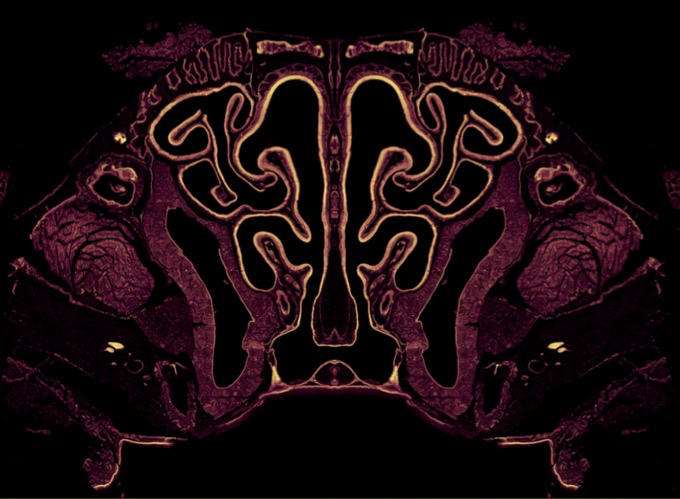Flu-fighting cells in noses could lead to one-shot flu vaccine

A sneeze is often the first sign of a cold or flu. But a sneeze, or more accurately our noses, could be the secret to stopping the influenza virus in its tracks through what scientists are calling a "nasal border patrol".
University of Melbourne researchers Dr Angela Pizzolla and Dr Linda Wakim at the Peter Doherty Institute for Infection and Immunity have discovered a special long-lived white blood cell in our noses that could open the way for a one-shot flu vaccine that can stop the virus from ever reaching our lungs.
While previous research into a universal vaccine has focused on the flu-fighting powers of white blood cells residing in lung tissue, the drawback has always been that these cells die too quickly to be useful in developing a vaccine. But the nose is the main port of entry for inhaled pathogens such as influenza virus, and, up until now, little was known about how the nasal border patrol worked.
"We took a step back and thought, 'What if we could stop the virus in the nose before it made it to the lung?'", says Dr Wakim, who specialises in microbiology and immunology.
"We moved our focus to investigating immune responses in nasal tissue, which is where the body first encounters flu viruses – a kind of nasal border patrol."
T cells by a nose
The researchers started by looking at a particular white blood cell – the resident memory CD8 T cells or Trms. Studies have already shown that these Trms, located in the lungs, are excellent at protecting against different strains of flu and, for a while, it was thought they were the ideal cell type to be targeted by a new vaccine.
The flu vaccine most people get each year works by stimulating white blood cells to produce the antibodies to fight a specific infection. But resident memory T cells, as their name might suggest, take up residence in and around organs, rather than living a roving life in the bloodstream.
But there's a catch - Trm cells in the lungs do not live very long. This took the research back to square one.

"We had identified a cell type that could provide great protection against different strains of influenza virus, but because they decayed so rapidly we would still have to constantly vaccinate the population," says Dr Angela Pizzolla, a Research Fellow at University of Melbourne.
So, the team started thinking about how the flu virus actually gets into the body in the first place.
Generally, virus particles are inhaled into the upper airways and nose - this is where the infection starts. The virus then replicates and migrates down into the lungs, causing the severe respiratory symptoms associated with influenza infection.
The researchers then found a population of Trms living in nasal tissue that, unlike their counterparts in the lung, can live for a very long time. They tracked these cells in lung and nasal tissue and found that while a population of lung Trms cells would drop at rate of 100,000 cells down to just 1000 cells over a period of 100 days, the Trms cell population in the nasal tissue remained stable.
This means that the flu-fighting cells in the nasal tissue can potentially disable the inhaled influenza virus in the nose and upper airways, preventing the infection from reaching the lungs. It also means scientists could look at developing a vaccine that stimulates these Trms in the nose, halting specific strains of virus before it even enters the respiratory system.
"We basically stopped influenza at the gates," says Dr Wakim.
Fighting the flu
The influenza virus is notoriously difficult to treat and manage.
It's highly contagious – meaning it is very good at spreading from person to person. Which is usually why once one person in a family, workplace or school class becomes infected, a lot more people around them ultimately become sick.
But the virus is also a 'master of disguise'. It's very good at altering what it looks like on the surface, which can confuse our body's immune system and prevent it from recognising the virus and fighting off the infection.
"This is a big problem for influenza vaccine development. Our current flu vaccines work by training the body to recognise a component on the surface on an influenza virus particle," says Dr Wakim.
Because the virus can change its appearance, it can actually evade our vaccines and this is why we need to be vaccinated against influenza virus every year. Scientists are constantly playing catch-up trying to predict what the next season's circulating influenza virus will look like and then developing tailor-made vaccines to protect against the circulating strain.
Currently there's a lot of scientific effort focusing on the development a "one-shot" flu vaccine. This is a vaccine that could be administered just once and provide long-term protection against any flu viruses you may encounter in your entire life – including any pandemic strains.
It is why researchers are focusing on Trms because these cells have the potential to provide protection against a variety of different influenza strains at the first site of infection.
"Instead of recognising external parts of the virus, which are constantly changing, these cells are trained to recognise internal parts of the virus. These parts of the virus are equivalent to our internal organs," says Dr Wakim.
It means a vaccine that induces flu fighting Trm cells in the nose could outwit the flu virus.
"We are now trying to work out the best way to lodge these flu-fighting cells in the nasal tissue, with the ultimate goal of developing a new vaccine that can provide long-term protection against all flu viruses."
More information: Resident memory CD8+ T cells in the upper respiratory tract prevent pulmonary influenza virus infection, Science Immunology, DOI: 10.1126/sciimmunol.aam6970




















